Rupestrian Paintings from the Archaeological Area of Piripiri, Piauí, Brazil: A Current Overview-Juniper Publishers
Archaeology & Anthropology-Juniper Publishers
Abstract
The rural area from the municipality of Piripiri, in the state of Piauí, Northeastern Brazil, is known to contain several archaeological sites, which are essentially sandstone shelters and walls decorated with rupestrian paintings and engravings. Located in the Corrente stream margins, predominantly in the villages known as Buriti dos Cavalos, Cadoz Velho, and Jardim, the rocky monuments present high density of prehistoric inscriptions. The rupestrian paintings mainly represent abstract figures, spear throwers, human handprints, anthropomorphs and zoomorphs, in different hues of red, but also in yellow, black, gray (including greenish-gray), green-olive, white, pink, wine, dark-purple and orangish. Besides the polychromy, the ancient inscriptions exhibit frequent overlaps and recurrences of the motifs represented in the rocky supports. Eight archaeological sites are briefly presented and their main features are described.
Keywords: Rupestrian paintings; rupestrian engravings; archaeological heritage; archaeological area of Piripiri; Brazil
Introduction
The Northeastern Brazil is a region extremely rich in archaeological sites [1,2]. Only in the Serra da Capivara National Park (Southeast Piauí), more than 940 archaeological sites are known [3-5]. The rupestrian paintings of these region were dated by combining different dating techniques on samples from several of those archaeological sites. Data accumulated up to now suggest that some inscriptions have ages estimated from ca. 30,000 years BP [6-9]. Due to their expressive number and the cultural value of these archaeological sites, especially those decorated with an exceptional collection of prehistoric rupestrian paintings, the Serra da Capivara National Park was formally recognized to be a Human Heritage by UNESCO (United Nations Educational, Scientific and Cultural Organization) [3,10]. Besides the Serra da Capivara National Park, the Serra das Confusões National Park [4] and the Sete Cidades National Park are particularly rich in archaeological sites.
Archaeological sites from Piripiri
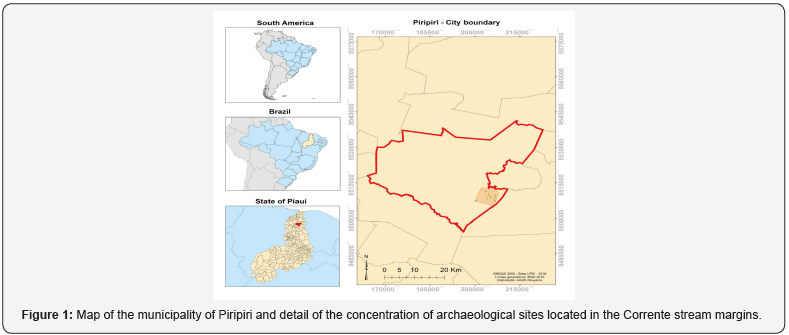
The objective of this review article is to present the main characteristics of the prehistoric rupestrian paintings from eight archaeological sites located in the rural area of the municipality of Piripiri (Figure 1), North Piauí, Brazil, which have been investigated since 2009 [11,12].
Pedra do Cantagalo I
Pedra do Cantagalo I is an archaeological site located in the Jardim village, rural area of the municipality of Piripiri. It consists of a sandstone shelter decorated with more than 1,950 rupestrian paintings representing mainly abstract figures, spear throwers, human handprints and anthropomorphic and zoomorphic motifs, in different hues of red, but also in yellow, black, gray, white, pink, wine, dark-purple and orangish [13,14] (Figure 2). Besides the high density of prehistoric inscriptions and polychromy, this archaeological site also stands out due to the overlaps and recurrences of the figures represented. Rupestrian engravings (some were painted), chipped lithics, polished lithics, ceramic fragments and mineral pigments in the form of red and yellow ochres also were found [13-15] (Figure 3).

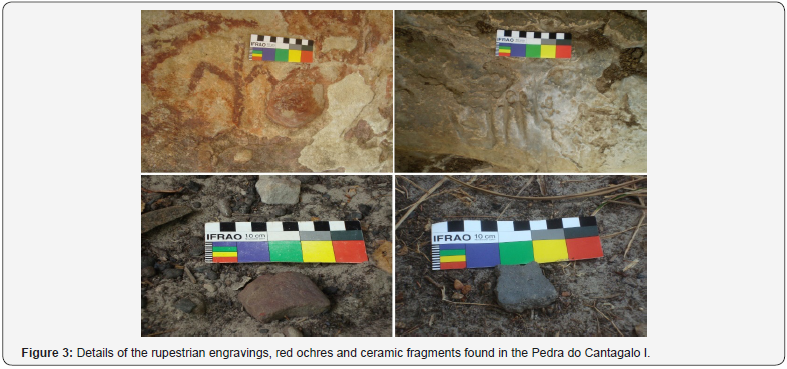
Residual charcoals found in well-structured hearths, as recently evidenced from excavations in this rocky shelter, were 14C-dated using accelerator mass spectrometry (AMS) as being from 1,180 ± 30 years before present (BP; calibrated result at 95% probability, 2σ, from 1,070 to 960 years cal BP; Beta-420913) [16,17]. Samples containing thin layers of paint from rupestrian paintings of different colors, as well as red and yellow ochres, ceramic fragments, palaeosediments and saline efflorescences samples collected in this archaeological site were investigated by energy dispersive X-ray fluorescence, CHN elemental analysis, scanning electron microscopy, energy dispersive spectroscopy, Fourier transform infrared spectroscopy, 57Fe- Mössbauer spectroscopy, Raman spectroscopy, grazing incidence X-ray diffraction, powder X-ray diffraction and magnetization measurements using vibrating sample magnetometer, in an effort to assess the chemical and mineralogical characteristics of these materials [14,16-21].
Despite of the several experimental difficulties to analyze these archaeological materials from the cultural heritage, particularly due to the complex chemical and mineralogical composition and to the exceptionally small amount of samples commonly available for manipulation in the laboratory, the chemical and mineralogical data provide stimulating evidences and detailed information about the chemical-mineralogical nature of these vestiges of prehistoric human activity from the rocky shelter Pedra do Cantagalo I.
The archaeometry has been used as an important tool for the analysis of several types of ancient materials of archaeological sites from Piauí and the 57Fe Mössbauer spectroscopy has been used as a non-destructive nuclear technique and decisively fundamental on the chemical-mineralogical characterization of ferruginous species of these materials [10,14,16,18-34].
Pedra do Atlas
The archaeological site known as Pedra do Atlas is a sandstone shelter located in the Buriti dos Cavalos village, rural area of the municipality of Piripiri, decorated with 423 rupestrian paintings represent abstract figures, spear throwers, human handprints and anthropomorphic and zoomorphic motifs, in different hues of red, yellow, gray, green-olive, white, pink, wine, dark-purple and orangish [35] (Figure 4). Among the most recurrent rupestrian paintings, there are 106 representations of spear throwers. Some rupestrian engravings are also observed. Recently, ceramic fragments, red and yellow ochres, and some lithic artifacts were found on the surface of the sheltered soil [32].
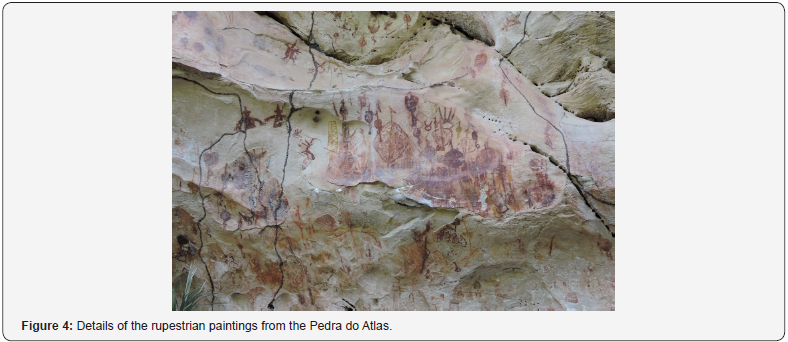
Following the same research strategy proposed for the Pedra do Cantagalo I site, samples containing thin layers of paint from rupestrian paintings of different colors, as well as red and yellow ochres, and saline efflorescences samples collected of the Pedra do Atlas site, were also investigated by several archaeometric techniques [30,32,36].
Cadoz Velho I
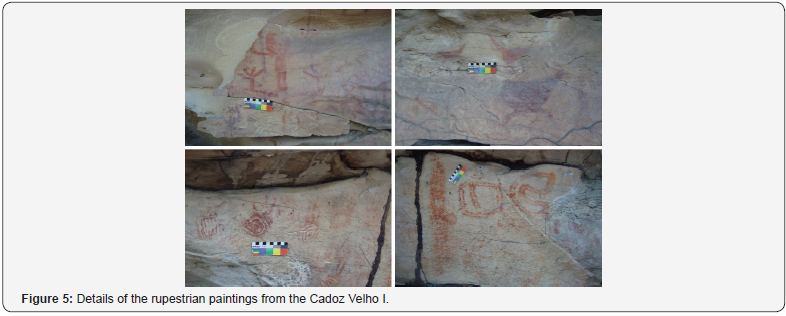
The Cadoz Velho I archaeological site is a sandstone shelter located in the Cadoz Velho village, rural area of the municipality of Piripiri, containing 214 rupestrian paintings that consists of abstract figures, human handprints, zoomorphic and phytomorphic motifs, painted predominantly in different tonalities of red, but also in orange [37] (Figure 5).
Fazendinha I
The archaeological site known as Fazendinha I is a sandstone shelter with prehistoric inscriptions located in the rural area of the municipality of Piripiri [38]. The rocky shelter contains an exceptional collection of 141 rupestrian paintings and 65 rupestrian engravings. The rupestrian paintings consist of abstract figures, spear throwers, human handprints, zoomorphs (lizards), anthropomorphs and phytomorphs, painted predominantly in different tonalities of red, but also in black, orangish, wine, darkpurple, and orangish-brown (Figure 6). The rupestrian engravings (made by pecking; some finished by abrading) represent mainly cupules, but also abstract figures and a lizard (the only engraved animal known in all prehistoric sites of the archaeological region from Piripiri) [38]. Most of the engravings were also painted. Besides the high density of rupestrian inscriptions, there are overlaps and recurrences between the painted and engraved motifs.
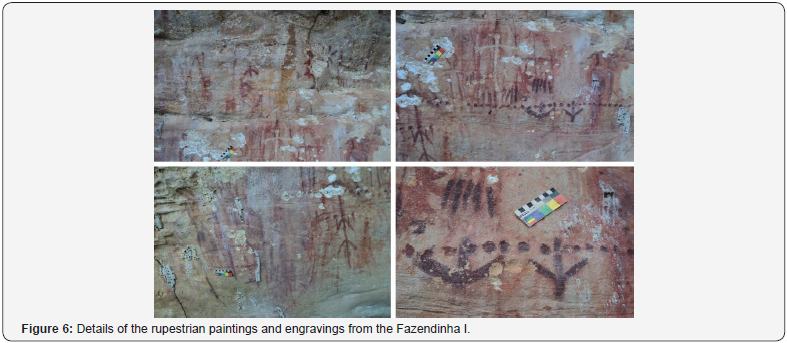
Caminho da Caiçara I
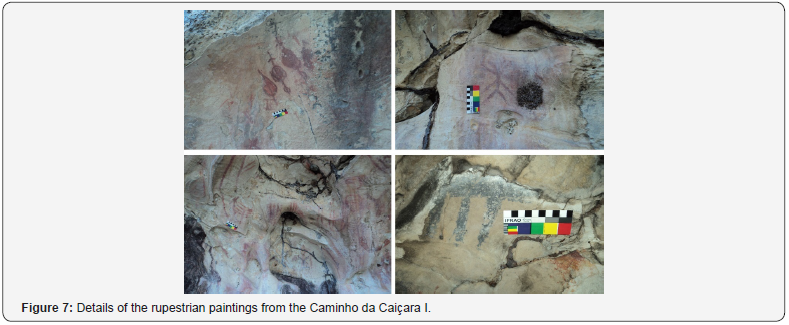
The Caminho da Caiçara I archaeological site is in the Cadoz Velho village, rural area of the municipality of Piripiri. The sandstone walls of this prehistoric shelter are decorated with 205 rupestrian paintings representing abstract figures, spear throwers, phytomorphs and anthropomorphs, painted predominantly in different tones of red, but also in black, yellow, brown, wine and orange [39] (Figure 7). In addition to a high density of rupestrian inscriptions, there are overlaps and recurrences of painted motifs, such as spear throwers, concentric circles, sequences of sticks, agglomerates of fingerings and phytomorphs. The rupestrian engravings include cupules.
Pedra Ferrada
The Pedra Ferrada is a sandstone complex located in the Oiticica village, rural area of the municipality of Piripiri, containing 37 rupestrian paintings represent abstract figures and human handprints in different hues of red, dark-purple and orangish [40] (Figure 8).
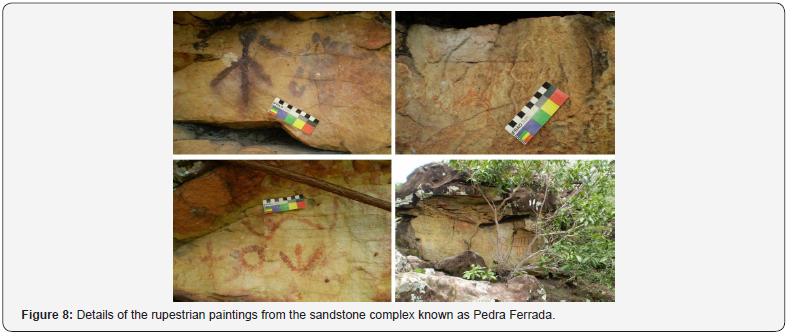
Pedra do Dicionário
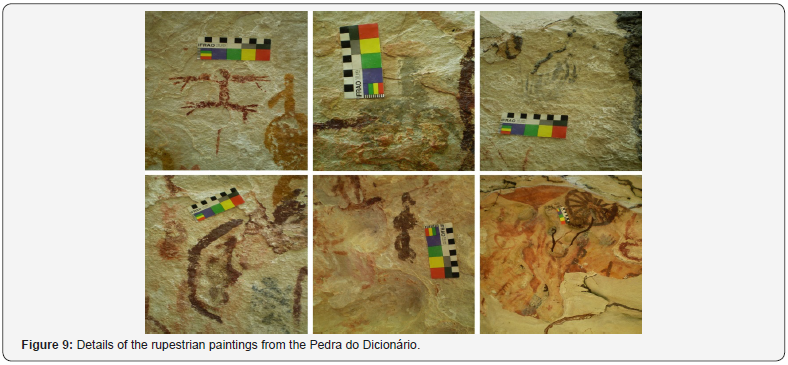
The Pedra do Dicionário is a rocky shelter located in the Buriti dos Cavalos village, rural area of the municipality of Piripiri. The sandstone walls of this archaeological site are decorated with 356 rupestrian paintings and a few rupestrian engravings in the shape of cupules; the paintings are representations of abstract figures, spear throwers, human handprints and zoomorphs, and were done predominantly in various shades of red, also existing inscriptions in yellow, wine, pink, black and orangish, highlighting a figure on the greenish-gray color, by its rarity [41] (Figure 9). Besides the polychromy, there are overlaps and recurrences of the figures represented, among which stand out 53 spear throwers and 11 human handprints.
Samples containing thin layers of paint from rupestrian paintings of different colors, as well as saline efflorescences samples collected of the Pedra do Dicionário site, were investigated by several archaeometric techniques [24].
Pedra da Biblioteca
The Pedra da Biblioteca is a sandstone shelter also located in the Buriti dos Cavalos village, rural area of the municipality of Piripiri [42]. This archaeological site is decorated with 90 rupestrian paintings, representing mainly abstract figures and spear throwers, in the gray, wine and orangish colors, and predominantly in different tonalities of red (Figure 10). Besides the prehistoric paintings, there are a few rupestrian engravings.
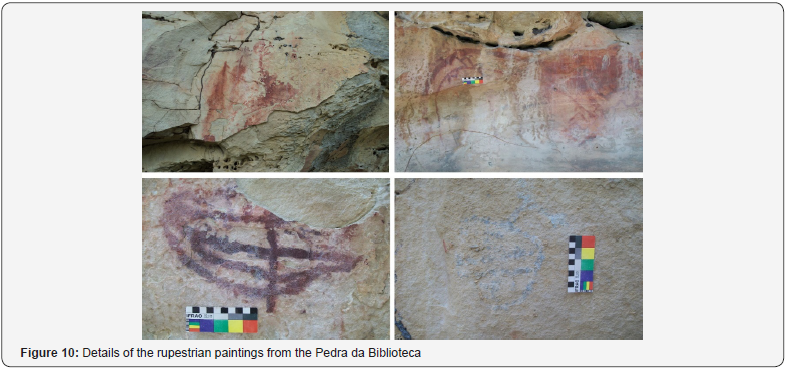
Conservation Problems from the Archaeological Sites from Piripiri
The causes of degradation of the archaeological sites from Piripiri are mainly of natural origin, due to the fragile constitution of the rocky support: the sandstone shelters are in advanced state of degradation, literally undergoing decomposition [13,35,37-42]. The state of conservation of rupestrian paintings and engravings is of concern: the prehistoric inscriptions suffer from the action of infiltrations and run-off of water, the resulting moisture encourages the formation of a variety of lichens, mosses and the growth of other microorganisms [13,35,37-42]. Suffer also by the thick layers of saline efflorescences, wind erosion, animal-dejects and insects (such as termites and wasp nests, and hives of bees), besides the mechanical, chemical and biological degradation caused by plants attaching to rocky supports.
Unfortunately, human interventions are also responsible for serious conservation problems in these archaeological sites, predominantly by deposition garbage on unguided visits, graffiti (including about the rupestrian paintings and engravings), removal of native vegetation surrounding of rocky shelters, and fires [13,35,37,40-42]. Domestic animals are also often found in the sandstone shelters, leaving thick layers of dejects on the archaeological sediments.
General Considerations and Future Challenges
The southeastern from Piauí is known internationally for presenting, in the area of the Serra da Capivara National Park and its surroundings, the largest concentration of archaeological sites containing rupestrian art, per square meter, of the world. However, the rest of Piauí, likewise, presents dotted with traces related to the presence of prehistoric human groups, especially, prehistoric cave paintings, found in shelters and rocky blocks from north to south.
In this article, it was shown that the municipality of Piripiri, in the north of Piauí, has an important concentration of sandstone shelters decorated with paintings and rock engravings. Despite of relatively smaller amount of data about such prehistoric sites, of the several difficulties, mainly to carry out field activities, the data already obtained provide stimulating evidences with detailed information about the graphic characteristics of this rich archaeological heritage. The preliminary survey of eight archaeological sites showed that these sandstone shelters present high density of rupestrian paintings made with different colors. Besides the polychromy, the prehistoric inscriptions exhibit frequent overlaps and recurrences of the motifs represented in the rocky supports, mainly spear throwers and human handprints. The graphic features these paintings are essentially different from those found in the Serra da Capivara National Park, Southeastern of Piauí.
The occurrence of serious conservation problems points to the need for urgent interventions, since some of them, such as termites, are moving forward quickly on the rupestrian paintings, besides of removal of graffiti, for example. Is need the elaboration of a pre-diagnosis, with proposals for action to remove or control the most degrading agents.
https://juniperpublishers.com/gjaa/GJAA.MS.ID.555725.php
For More Articles in Global Journal of Archaeology & Anthropology Please
Click on: https://juniperpublishers.com/gjaa/index.php
For More Open Access Journals In Juniper Publishers Please click on: https://juniperpublishers.com/index.php




Comments
Post a Comment